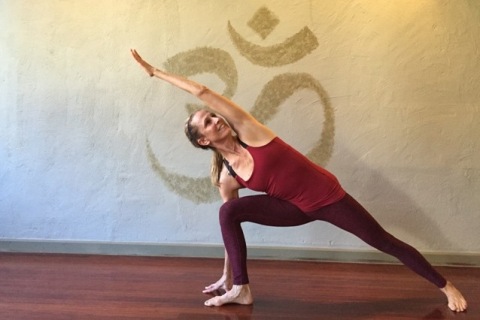The transition from one pose to another requires the ability to do the two postures individually. It is also important to understand how the actions of one pose are developed and then get carried on to the next. There is a progression in learning yoga poses.
Wide Legged Forward Fold is typically learned beforeinversions because it gets the head lower than the heart preparing the body forinverting. The placement of the head andhands in Prasarita Padottanasana sets the foundation for Headstand II. A couple of important points in this standingpose are the straightness of the legs due to the engagement of the quadricepsand the ability to hinge at the hips and elongate the trunk to get the top ofthe head towards the floor.
The Straightness of the Legs.
This is often a point of confusion for students who havebeen taught to soften their knees in standing poses. This may be a good cue for gentle yogaclasses where the aim is to breathe and move and where the poses are notbuilding upon each other but are done for their own sake. But, if you are interested in a progressivepractice that teaches you to do more complex poses, then the basics need to belearned. In straight leg poses the legsare meant to be straight, which is not locked out and hyper-extended – that isa different problem! In order tostraighten the legs, the quadriceps muscles need to be engaged which in turndraws the knee caps up into the thigh. You can tell if your quads are engaged if, when you grab your knee capwith your fingers, you cannot wiggle it from side to side.
If you look at my legs in Prasarita Padottanasana,
Wide-Legged Forward Fold
in the Wide Legged transition between the Forward Fold and Headstand,
and then in Sirsasana II itself,
there is never a point where my legs are bent, or my knees are “soft”. This engagement of the legs does two things: it allows me to bend and hinge only at the hip joint and not at the knees and low back, and it keeps my awareness focused on balancing my body parts by knowing where they are and what they are doing in space. And it allows me to balance!
Try this: Find abroomstick or a yardstick, dowel or even a baseball bat and place it on yourpalm or the finger tip of one hand and, without gripping it with your fingers,see if you can balance it. Chances arethat you will be able to, at least for a little while. Now, imagine that the thing you are balancinghad a joint in the middle that was soft and wiggly. Would you still be able to balance thestick? The answer is no, because the toppart would fall in the direction of the bend and you would have no control overit. Engaging your muscles is exertingcontrol over your body.
Check out this handstand video clip. Notice how straight her arms and legs arefrom the forward fold into the handstand. There is only a slight bend in the leg she uses to hop up: https://www.pinterest.com/pin/119908408816084757/
So the first skill we will work on this month is tostraighten and strengthen the legs. Wewill work on this in Triangle, Pyramid Pose, Warrior III, Half Moon Pose andStanding Hand to Big Toe Pose.
Next week we will work on Tripod Headstand. Then, before you learn to lift from Wide Legged Forward Fold into Tripod Headstand, you will learn to come down from Tripod Headstand into Wide Legged Forward Fold. First we will do this one leg at a time, without falling out and then with both legs at the same time. After that, you will be ready to learn to lift up from Prasarita Padottanasana into Sirsasana II.



























